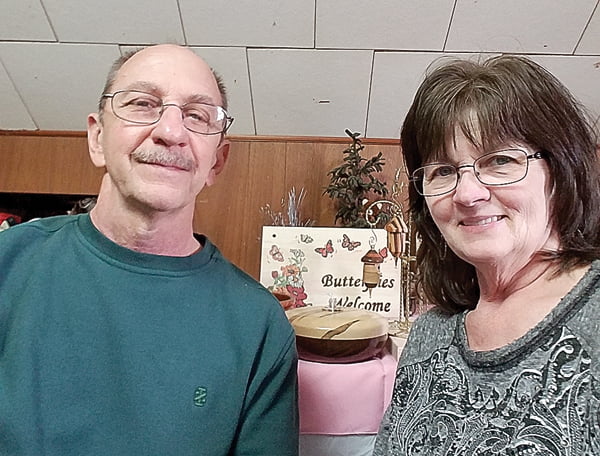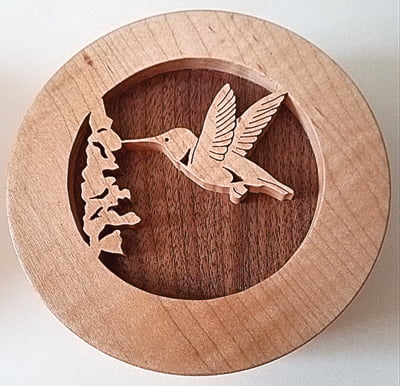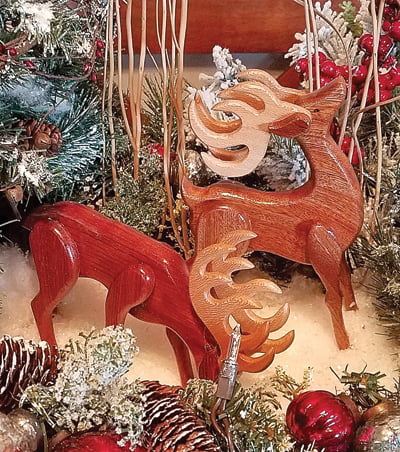

Ken Springer
Watoga Park Foundation
The Black Walnut
Part Three – Black Walnut as Art
I am in no sense of the word an artist, but I generally recognize good work when I see it, and I have great admiration for those who can create beauty, regardless of the medium in which they work.
And, if I do possess any talent at all, it is a habit of consistently bumping into those who do have exceptional abilities. Often these people are characters in their own right, possessing stories that match their sense of adventure, creativity and individualism.
Because I can cobble a few words together reasonably well, I see it as my civic duty to share with others the beauty that gifted people create, in the firm belief that we all benefit immensely from art.
Mark and Marti Reed brought into their marriage a mutual love of working with wood. They make objects that inspire and give enduring joy. Each is quick to give credit to the other as the “real” talent behind their beautiful creations. That is to be expected of two people who love and respect each other, as do Mark and Marti.
But I suspect that Mark and Marti have that rare situation where it requires both of their minds working in tandem to bring forth the magic.
Mark was not raised in an environment one would expect of a young man who would later become adept at hunting, fishing and trapping. One who would quickly pick up the skills of an outdoorsman and become a career officer with the Ohio Department of Natural Resources.
He grew up on the mean streets of Cleveland, Ohio.
“My family’s food-gathering practices took place in a grocery store, and I was 20 years-old before I knew that walnuts had a fleshy husk around them,” Mark said.
“It was when I moved to southeastern Ohio to attend college that I first learned to identify Juglans nigra in a tree identification class, by its pinnately compound leaves, its distinctive bark and its unmistakable fruit. A few years after that, I learned that I could use the husks to dye traps, and that was probably my first experience utilizing black walnut for something other than food.”

Fortunately, Mark did not hold back when it came to discussing why he likes to work with wood, especially black walnut.
“For us, wood is an art medium that has a beauty of its own, even before we do anything to it. Compared to media like metal or stone, wood has a warmth and a depth that invites a person to touch it and experience it in a way that paintings and sculpture normally do not.
“There are probably all kinds of zen-like theories explaining our innate human connection to trees and wood, but we might get too bogged down discussing them here. Suffice it to say, Marti and I have always told people that praise our work that it’s the wood that makes us look good.”
I wondered if Mark and Marti come up with the ideas for their creations individually or jointly?
“Of the two of us, Marti is the artist. She has a boundless imagination and the ability to produce exactly what she envisions in her mind’s eye. I, on the other hand, tend to be more of a technician that turns a vague idea into a finished product through a system of trials, errors, tweaks and corrections. What I lack in talent, I make up for with persistence and a few tricks I’ve picked up along the way.”
Mark speaks eloquently about the artistic process in turning a piece of wood into something pleasing to the eye and the senses.
“Speaking only for myself, the secret to beautiful woodcraft is to enhance the wood’s natural warmth and depth by taking advantage of its color and grain, giving it an interesting form, and bringing out its luster with a finish that plays subtly with light and shadow.
“One of the ways I do all that is to use more than one kind of wood in any given project. It helps me develop visual interest through contrast and shading. The wood I use the most is black walnut. The color can range from chocolate brown to creamy yellow, and combined with other domestic hardwoods like cherry and maple, and the effects can be quite striking.
“Depending on the piece, I sometimes use walnut as a “stand-alone,” but because the grain tends to be regular, and therefore not particularly eye-catching, I have to rely on its deep, vibrant color, graceful lines and a lustrous finish. It usually works, and when it doesn’t, it’s usually on me.”
I asked Mark about the qualities of working with black walnut that makes it so unique.
“Black walnut is a medium-hard domestic hardwood. By that, I mean it is harder than cherry and soft maple but not as hard as oak and hard maple. The grain is usually straight and, therefore, easy to work with. It’s fairly forgiving on the lathe, takes glue well because it’s not oily, and pops with new life when it gets hit with the finish of choice.
“On most of my small pieces that incorporate walnut, I go with a high gloss finish to bring out as much luster as I can. From Christmas ornaments to cutting boards, it is the rare piece that doesn’t have some black walnut in it somewhere.”
Unlike Mike Smith, Mark is not in a position to cut his own hardwood trees, nor does he have a portable sawmill.
“Black walnut is considered a premium hardwood and tends to be expensive compared to other domestic hardwoods. The last time I priced it (about a year ago), walnut was about ten dollars a board foot. Cherry and oak were approximately five dollars a board foot at the time.
“Most of the time, I stay supplied with walnut by buying scraps and cut-offs, getting bargain pricing at estate auctions, and accepting all the freebies I can get. Regardless of how I acquire it, I never let the supply run low. Woodworking would not be the same without it.”
I asked Marti if it was true that they have “his” and “hers” lathes. Marti, a former paramedic, and trainer in EMS, paramedic and advanced cardiac courses didn’t hesitate.
“After Mark and I completed our first class in using a lathe, we purchased two lathes, one for Mark and one for me.”
Now, there’s a match made in Heaven, or at the very least, the lumberyard.
Author’s Note: I have known Mark since the late 70s when we worked together for Ohio Department of Natural Resources. For 10 years or so, he was my neighbor in Mt. Nebo, West Virginia.
On a chilly morning in the middle of March in 2007 I dropped Mark off on the shoulder of a two-lane highway just outside of Wytheville, Virginia. He attached panniers to his bicycle, we shook hands, and I watched as he pedaled west and out of view.
He didn’t stop until he dipped the front tires of his bike into the Pacific Ocean in San Diego some three months later. Although Marti and his friends were left behind, Mark kept us up to date on his adventures with regular dispatches from public libraries scattered along his entire route.
His essays from the road became something we all looked forward to. His readers were spellbound by his descriptions of our beautiful country as seen from the seat of a bicycle. At times we were sitting on the edge of our own seats by his vivid description of his adventures and misadventures on the open road.
He wrote quite eloquently of the people he met along the way. Often emphasizing that on the occasions his bike needed essential parts or he was unable to find a place to pitch his tent when the sun was getting low on the horizon, there was always somebody who came to the rescue, often going out of their way to do so.
Mark reassured us that this country is still full of generous and compassionate people, willing to lend a hand to a stranger.
Next Week: The Dark Side of Black Walnut. (No pun intended).
Take heart dear reader: We will get to the other side of this pandemic. After all, West Virginians are a resilient people!
Ken Springer
Ken49bon@gmail.com



